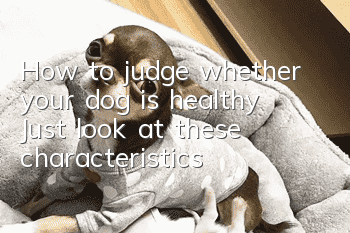How to judge whether your dog is healthy? Just look at these characteristics!

How to judge whether a dog is healthy? Many people think that dogs have no obvious diseases and are healthy if they can eat and sleep. Although this is generally true, some diseases are not serious at the beginning, but will change through certain details of the body. If discovered in time, it will be fine, but if it is ignored, it will become worse over time. It becomes a disease. In addition to regular vaccination and deworming, you can also check whether your dog is healthy based on these details of your dog.
How to judge whether a dog is healthy?
One: Measure the dog’s temperature
The normal body temperature of a healthy dog is about 37.5 to 39°C. It is abnormal if the measured body temperature is too low or too high. Of course, the body temperature of larger dogs is relatively low, and the body temperature of small dogs and young dogs is generally higher, but Will not exceed 39 degrees, unless after strenuous exercise.
Two: Observe the dog’s eyes
A healthy dog's eyes are bright, not cloudy, and have no tear stains. Put your hand in front of the dog's eyes, and then move it left and right. If the dog's eyes can follow your hand and move back and forth, it will be very cute and energetic. If the dog’s eyes are bloodshot, the eyeballs are covered with albuginea, or there is a lot of eye feces in the corners of the eyes. If the whites of the eyes are too much, the eyes are white or dirty, and there is a lot of secretion in the corners of the eyes, there may be a physical reason. If it is not anemia, it means that the dog may be suffering from anemia. Beset by certain illnesses.
3. Observe the dog’s nose
By observing the dog’s nose, a healthy dog’s nose will be moist, cool, and rarely secreted even in summer; if you find that your dog’s nose is dry, you need to find out what the cause is. . In addition, dogs may sometimes have runny noses. If the nasal discharge is clear, you don’t need to worry too much. This is normal. And if your dog has yellow snot, it is likely to have a respiratory disease.
4. Observe the dog’s ears
A healthy dog can look for the source of the sound based on the sound. For example, you can make a sound behind or to the side of the dog. If the dog looks for the source of the sound, it means that its hearing is normal. In addition to the hearing examination, you should also check whether there are bleeding, parasites, redness, swelling, etc. inside the dog's ears. If there are any, it means that the dog is not healthy and needs treatment.
5. Observe the dog’s mouth
Healthy dogs have pink gums, white teeth, and no bad breath; if the gums are gray and white, it means that the dog is weak, which may be caused by malnutrition or anemia; if there is bad breath, yellow teeth, etc., it means that the dog may be suffering from stomachquestion. If you find that you have bad breath after raising your dog, it is recommended that you give your dog a light diet or give it some teething snacks to eliminate bad breath. It is also recommended that you grind your dog's teeth more often to prevent the dog from developing oral problems.
6. Observe the dog’s foot pads
The pads of adult dog’s feet are plump and firm, while the pads of young dogs’ feet are soft and delicate. If the dog's footpads appear dry and cracked, it means that it is malnourished; if the footpads of young dogs appear hard, it may indicate the occurrence of canine distemper.
7. Observe the dog’s fur
There are four places you need to pay attention to when checking your dog’s fur: around the mouth, neck, behind the ears and thighs. If flakes or patches of red appear in these areas, it indicates that the dog is infected with mites or fungi, while small black particles in the hair indicate flea infection. Healthy dogs generally have clean fur, shiny back hair, and smooth and elastic skin. However, very few dogs will suffer from hair or skin diseases, such as fleas, mites, etc. If a dog that is prone to hair loss lacks protein, a dog with dry and split hair may be malnourished or anemic.
8. Observe your dog’s poop
Look at the dog's poop. I believe that when many people first bought a dog, the seller has told you to determine the dog's food intake by observing the dog's poop. If the dog eats more, it will be looser, and if it eats less, the poop will be drier; believe us Sometimes when you go to the hospital to see a doctor, the doctor will ask how your stool has been recently, what color it is, etc. The description helps the doctor judge the condition. In fact, this is also the case with dogs. You can judge the condition of the dog based on its poop. , generally the colors of dog poop are orange, green, red, gray, and black, which are unhealthy.
- Things to note when training your dog by name
- What should I do if my puppy is afraid to go out?
- Reasons why dog vaccinations fail
- What should you pay attention to when training a hunting dog? A must-read for dog training!
- What should you pay attention to when your dog is pregnant?
- Tips for cleaning your Samoyed dog’s hair
- A dog trainer worth $7 billion tells you how dogs should be trained like this
- What symptoms do pit bulls have when they catch a cold?
- What medicine is good for pet dogs with skin diseases?
- Is Keeshond easy to raise? Keeshond dog pictures | price | training



